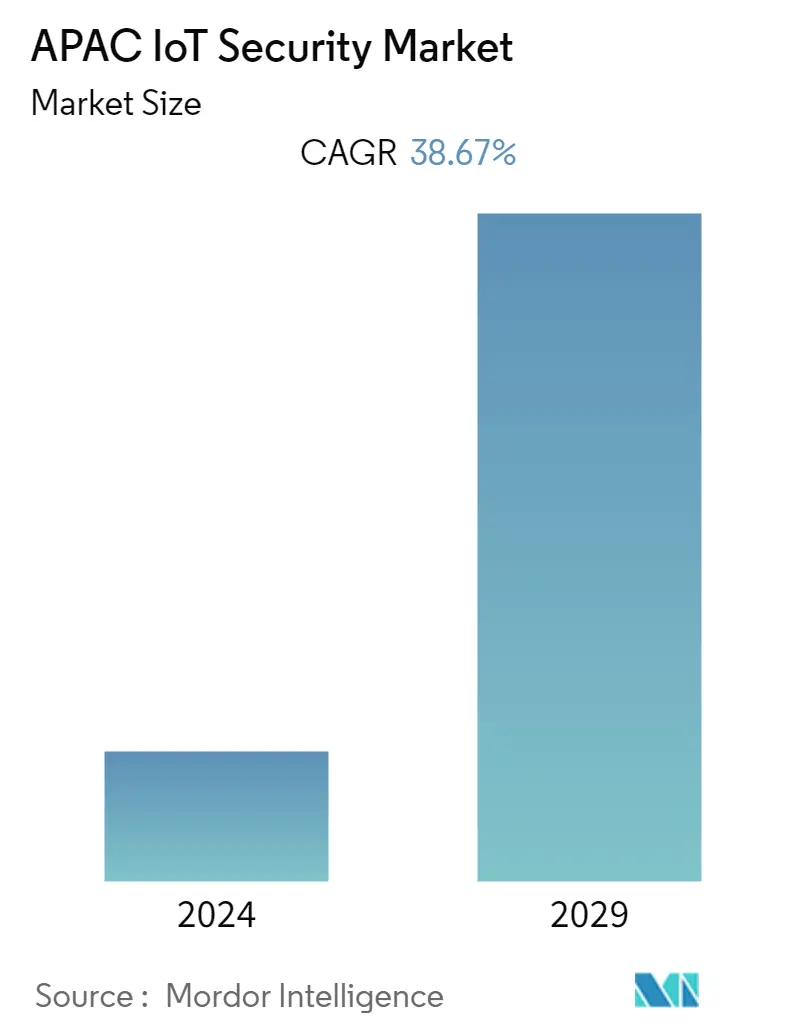Market Size of APAC IoT Security Industry

| Study Period | 2021 - 2029 |
| Base Year For Estimation | 2023 |
| Forecast Data Period | 2024 - 2029 |
| Historical Data Period | 2021 - 2022 |
| CAGR | 38.67 % |
| Market Concentration | Low |
Major Players
*Disclaimer: Major Players sorted in no particular order |
Need a report that reflects how COVID-19 has impacted this market and its growth?
APAC IoT Security Market Analysis
The Asia-Pacific Internet of Things (IoT) Security Market has registered a CAGR of 38.67% during the forecast period. COVID-19 played a significant role in giving rise to the work-from-home concept, increasing the demand for IoT security solutions to improve safety and provide real-time monitoring to bring transparency. The market is growing because there are more ransomware attacks on different IoT devices and more IoT security regulations in the developing economies in the region. Malware and phishing attacks on different businesses are also helping the market grow.
- The Asia-Pacific region has surfaced as a manufacturing hub, owing to the low production costs in emerging countries such as India and China, which remain a significant market in Asia Pacific's IoT security market. Investments are being planned for the quality of growth, addressing environmental concerns, and reducing overcapacity. The region's automotive industry has emerged as one of the world's largest and is expected to grow further over the next five years.
- India is the fastest-growing economy in the world, and generating enough energy is the key to achieving developmental ambitions that support expansion. The country is regarded as a newly industrialized landscape, becoming a preferred manufacturing hub. India is far superior to many nations in manufacturing medical drugs and products.
- Cyber attackers took advantage of the conditions created by the COVID-19 pandemic in the region and targeted sectors like hospitals, medical and pharmaceutical manufacturers, and other companies. According to the latest IBM X-Force Threat Intelligence Index report, Asia saw a high volume of attacks on finance and insurance organizations last year, accounting for 34% of all attacks on this industry.
- APAC is one of the fastest-growing regions in digital transformation and internet penetration and has experienced exponential growth in financial technology and e-commerce, resulting in a rising demand for Internet and broadband services. This change has brought many benefits and has a lot of potential for the future, but it has also opened the door to a large number of cybersecurity threats, which is driving the growth of the market.
- The rise in connectivity between companies in the region has exposed vulnerabilities in hardware and software environments, giving cybercriminals greater attack surfaces to exploit. This includes employees' smaller, personal IoT devices, which can provide a potential backdoor into more well-protected systems. Further, several countries have attempted to impose data protection and breach notification laws. However, as a whole, cybersecurity regulation in Asia-Pacific is still in the early phases of development and tends to focus mainly on critical infrastructure and regulated industries.
